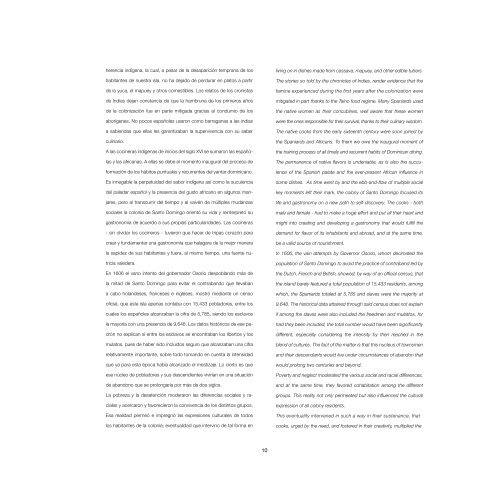Sabores-Ancestrales-Digital-1
Create successful ePaper yourself
Turn your PDF publications into a flip-book with our unique Google optimized e-Paper software.
herencia indígena, la cual, a pesar de la desaparición temprana de los<br />
habitantes de nuestra isla, no ha dejado de perdurar en platos a partir<br />
de la yuca, el mapuey y otros comestibles. Los relatos de los cronistas<br />
de Indias dejan constancia de que la hambruna de los primeros años<br />
de la colonización fue en parte mitigada gracias al condumio de los<br />
aborígenes. No pocos españoles usaron como barraganas a las indias<br />
a sabiendas que ellas les garantizaban la supervivencia con su saber<br />
culinario.<br />
A las cocineras indígenas de inicios del siglo XVI se sumaron las españolas<br />
y las africanas. A ellas se debe el momento inaugural del proceso de<br />
formación de los hábitos puntuales y recurrentes del yantar dominicano.<br />
Es innegable la perpetuidad del sabor indígena así como la suculencia<br />
del paladar español y la presencia del gusto africano en algunos manjares,<br />
pero al transcurrir del tiempo y al vaivén de múltiples mudanzas<br />
sociales la colonia de Santo Domingo orientó su vida y reinterpretó su<br />
gastronomía de acuerdo a sus propias particularidades. Las cocineras<br />
- sin olvidar los cocineros - tuvieron que hacer de tripas corazón para<br />
crear y fundamentar una gastronomía que halagara de la mejor manera<br />
la sapidez de sus habitantes y fuera, al mismo tiempo, una fuente nutricia<br />
valedera.<br />
En 1606 el vano intento del gobernador Osorio despoblando más de<br />
la mitad de Santo Domingo para evitar el contrabando que llevaban<br />
a cabo holandeses, franceses e ingleses, mostró mediante un censo<br />
oficial, que esta isla apenas contaba con 15,433 pobladores, entre los<br />
cuales los españoles alcanzaban la cifra de 5,785, siendo los esclavos<br />
la mayoría con una presencia de 9,648. Los datos históricos de ese padrón<br />
no explican si entre los esclavos se encontraban los libertos y los<br />
mulatos, pues de haber sido incluidos seguro que alcanzaban una cifra<br />
relativamente importante, sobre todo tomando en cuenta la intensidad<br />
que ya para esta época había alcanzado el mestizaje. Lo cierto es que<br />
ese núcleo de pobladores y sus descendientes vivirían en una situación<br />
de abandono que se prolongaría por más de dos siglos.<br />
La pobreza y la desatención moderaron las diferencias sociales y raciales<br />
y acercaron y favorecieron la convivencia de los distintos grupos.<br />
Esa realidad permeó e impregnó las expresiones culturales de todos<br />
los habitantes de la colonia; eventualidad que intervino de tal forma en<br />
living on in dishes made from cassava, mapuey, and other edible tubers.<br />
The stories so told by the chronicles of Indies, render evidence that the<br />
famine experienced during the first years after the colonization were<br />
mitigated in part thanks to the Taino food regime. Many Spaniards used<br />
the native women as their concubines, well aware that these women<br />
were the ones responsible for their survival, thanks to their culinary wisdom.<br />
The native cooks from the early sixteenth century were soon joined by<br />
the Spaniards and Africans. To them we owe the inaugural moment of<br />
the training process of all timely and recurrent habits of Dominican dining.<br />
The permanence of native flavors is undeniable, as is also the succulence<br />
of the Spanish palate and the ever-present African influence in<br />
some dishes. As time went by and the ebb-and-flow of multiple social<br />
key moments left their mark, the colony of Santo Domingo focused its<br />
life and gastronomy on a new path to self-discovery. The cooks - both<br />
male and female - had to make a huge effort and put all their heart and<br />
might into creating and developing a gastronomy that would fulfill the<br />
demand for flavor of its inhabitants and abroad, and at the same time,<br />
be a valid source of nourishment.<br />
In 1606, the vain attempts by Governor Osorio, whom decimated the<br />
population of Santo Domingo to avoid the practice of contraband led by<br />
the Dutch, French and British, showed, by way of an official census, that<br />
the island barely featured a total population of 15,433 residents, among<br />
which, the Spaniards totaled at 5,785 and slaves were the majority at<br />
9,648. The historical data attained through said census does not explain<br />
if among the slaves were also included the freedmen and mulattos, for<br />
had they been included, the total number would have been significantly<br />
different, especially considering the intensity by then reached in the<br />
blend of cultures. The fact of the matter is that this nucleus of townsmen<br />
and their descendants would live under circumstances of abandon that<br />
would prolong two centuries and beyond.<br />
Poverty and neglect moderated the various social and racial differences,<br />
and at the same time, they favored cohabitation among the different<br />
groups. This reality not only permeated but also influenced the cultural<br />
expression of all colony residents.<br />
This eventuality intervened in such a way in their sustenance, that<br />
cooks, urged by the need, and fostered in their creativity, multiplied the<br />
10


